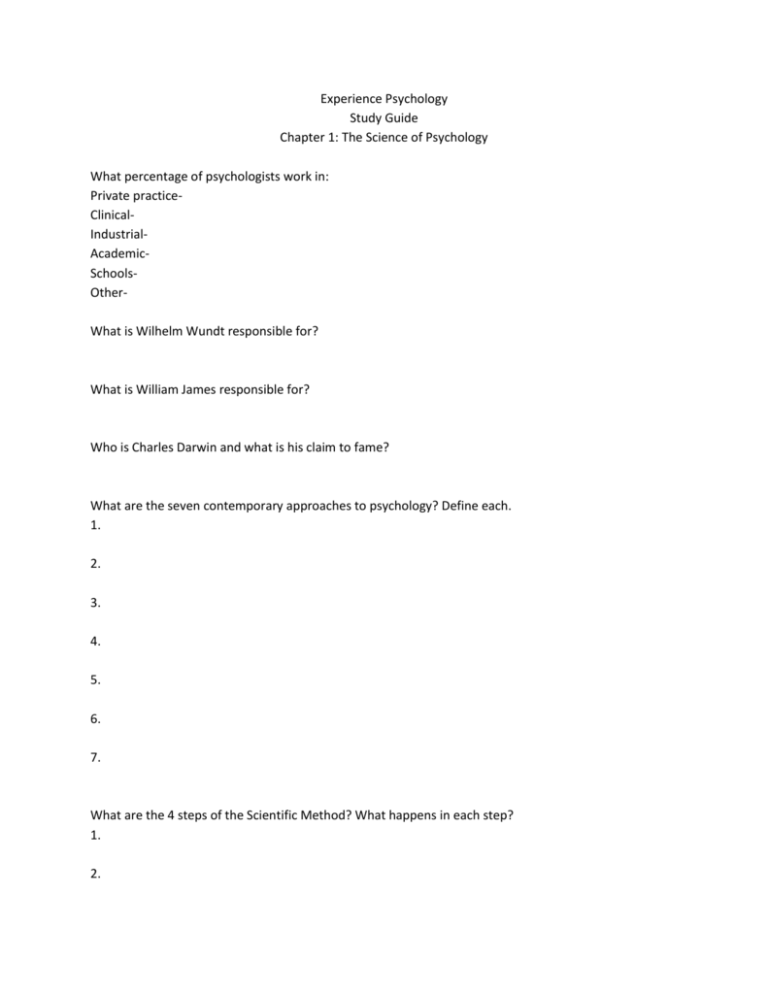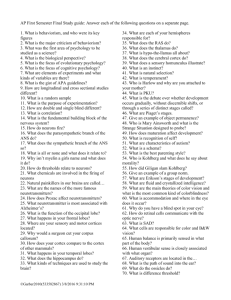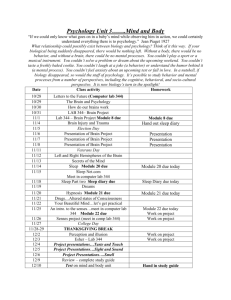Experience Psychology Ch.1
advertisement

Experience Psychology Study Guide Chapter 1: The Science of Psychology What percentage of psychologists work in: Private practiceClinicalIndustrialAcademicSchoolsOtherWhat is Wilhelm Wundt responsible for? What is William James responsible for? Who is Charles Darwin and what is his claim to fame? What are the seven contemporary approaches to psychology? Define each. 1. 2. 3. 4. 5. 6. 7. What are the 4 steps of the Scientific Method? What happens in each step? 1. 2. 3. 4. What are three types of research? Define each and give examples. 1. 2. 3. What is the Third Variable Problem? Define Longitudinal Designs. What is the difference between external validity and internal validity? What is the difference between experimenter bias and research participant bias? Population is: Sample is: Random samples likely to be______________ of _________________, to allow __________________ of research results. Where can research take place? In research what are some examples of research that could cause ethical dilemmas? What are APA ethical guidelines? Describe. Experience Psychology Chapter 2: The Brain and Behavior What are some characteristics of the nervous system? There are three different pathways discussed in the nervous system, what are they? What is CNS? Describe. What is PNS? Describe. What are the two PNS divisions of the nervous system? 1. 2. Define the “Fight or Flight” reaction. What are corticosteroids? What is the difference between acute stress and chronic stress? Match the following: 1. 2. 3. 4. 5. 6. Neurons Glial Cells Cell Body Dendrites Axon Myelin Sheath a. contains nucleus b. layer of fat cells, encasing/insulating most axons c. support, nutritional benefits d. carries information from cell body toward other cells e. nerve cells f. fibers projecting from neuron Label: The Neuron What is Neural impulse? What happens in Resting Potential? Discuss the all-or-nothing principle: What happens in the Action Potential? What is the difference between Synapses and Neurotransmistters? How do synapses and transmitters work? What does ACh stand for? Define what it does. What does GABA stand for? Define what it does. Define: Norepinephrine: Dopamine: Serotonin: Endorphins: Oxytocin: What is the difference between agonist and antagonist? Brain lesioning is: Electrical recording is: Brain Imaging- Fill in. X-Ray Images - _____________________________________ CT (or CAT) scan images _______________________________________ PET Scan _________________________________ MRI ___________________________________ fMRI ____________________________________________ Match. 1. Hindbrain 2. Midbrain 3. Forebrain a. uppermost region of brain b. adjacent to top part of spinal cord c. rises above hindbrain What are four components of Hindbrain? Define each. 1. 2. 3. 4. What is reticular formation? What are five parts of the forebrain? Define each. 1. 2. 3. 4. 5. **What are the various parts of the cerebral cortex? Label: What are the three components of Cerebral hemispheres? Match the following parts of the Endocrine System: 1. 2. 3. 4. 5. 6. 7. Endocrine system Glands Hormones Pituitary gland Adrenal glands Pancreas Ovaries and testes a. chemical messengers produced by endocrine glands b. regulate mood, energy level, and ability to cope with stress c. set of glands that regulate activities of certain organs d. controls growth and regulates other glands e. organs or tissues that create chemicals that control bodily functions f. produce hormones related to sexual development and reproduction g. performs digestive and endocrine functions Define: Collateral sprouting: Substitution of function: Neurogenesis: Brain grafts: Stem Cells: Match: 1. 2. 3. 4. 5. Chromosomes a. international research program mapping human genome DNA b. units of hereditary information Genes c. complete set of genetic instructions for making an organism Genome d. complex molecule that carries genetic information Human Genome Project e. threadlike structures containing DNA Define: Dominant Recessive Gene Principle: Polygenic Inheritance: Molecular Genetics: Selective Breeding: Behavior Genetics: Twin Studies What is the difference between genotype, phenotype, and genetic expression? Experience Psychology Ch. 3 Sensation and Perception What is the difference between sensation and perception? What is Bottom-Up Processing? What is Top-Down Processing? Adaptation improves a species’ _____________ for _______________ and an organism must be able to _____________ and _______________ quickly. Define sensory receptors. Photoreception: Mechanoreception: Chemoreception: Synaesthesia: Phantom Limb Pain: ESP: What is the difference between absolute threshold and difference threshold? What is Weber’s Law? What is Subliminal Perception? Discuss Signal Detection Theory and its possible outcomes. What are three characteristics of attention? 1. 2. 3. What is perceptual set? What is sensory adaptation? Light is the form of electromagnetic energy…Fill in what form of light is visible. Wavelenth Amplitude Purity Structure of the Eye. Match. 1. 2. 3. 4. 5. 6. Sclera Iris Pupil Cornea Lens Retina a. opening in center of iris, size controlled by muscles in iris b. clear membrane just in front of eye c. colored part of eye d. multilayered, light sensitive surface at back of eye e. white, outer part of eye, helps maintain shape of eye f. transparent, somewhat flexible, disk like structure Label: What are visual receptor cells? What are rods? What are cones? What is the tiny area in the center of retina called? What is a blind spot? Show the progress of visual processing. Optic Nerve_______________________ __________________________ Optic nerve fibers divide at optic chiasm: Left visual field____________________ Right Visual field _________________________ Feature detectors: Parallel Processing: Binding: What is Trichromatic Theory? What is Opponent-Process Theory? Contour: Figure-ground relationship: Gestalt Psychology: What is the difference between binocular cues and monocular cues? What involves perceiving motion? What does perceiving constancy mean? Sound is the _________________ in air processed by _____________ system Wavelength_____________________ ________________________ Amplitude _____________________ ________________________ Complexity _____________________ _________________________ What are the functions of each: Outer Ear: Middle Ear: Inner Ear: What is the Place Theory of Hearing? What is the Frequency Theory of Hearing? What is the Volley Principle? Auditory Processing: Inner Ear_______________________ _________________________ Most fibers cross over midline between hemispheres: Left Ear Right Ear What does localizing sound mean? What are three senses associated with Skin (Cutaneous) Senses? 1. 2. 3. Prostaglandins: Neural pathways to brain: Fast pathway Slow pathway What are endorphins? What are two examples of chemical senses? Explain both. What is the difference between kinesthetic sense and vestibular sense? What is proprioceptive feedback? What are semicircular canals? Experience Psychology Chapter 4: States of Consciousness What is consciousness? Who is associated with the stream of consciousness? What is arousal? What is it determined by? What is the Theory of Mind? Fill in the blanks: Define the following Biological Rhythms: Sleep: Biological rhythms: Circadian rhythms: Suprachiasmatic nucleus (SCN): Describe biological clocks: Why do we sleep? What is caused by sleep deprivation? What are the stages of wakefulness? What is Sleep Stage 1? Sleep Stage 2? Sleep Stage 3 and 4? REM sleep is… What constitutes one sleep cycle? What is reticular formation? What three neurotransmitters are involved in sleep? What are some diseases associated with sleep? What are some examples of sleep disorders? Define. What did Freud say about dreams? What is cognitive theory? What is activation-synthesis theory? What are the effects of uses of psychoactive drugs? Define addiction. What are depressants? Give examples. What are stimulants? Give examples. What are hallucinogens? Give examples. Explain Hypnosis. What is the purpose or use of hypnosis? What is meditation? Good luck! You’re going to do awesome!! Love, Ms.Smith






